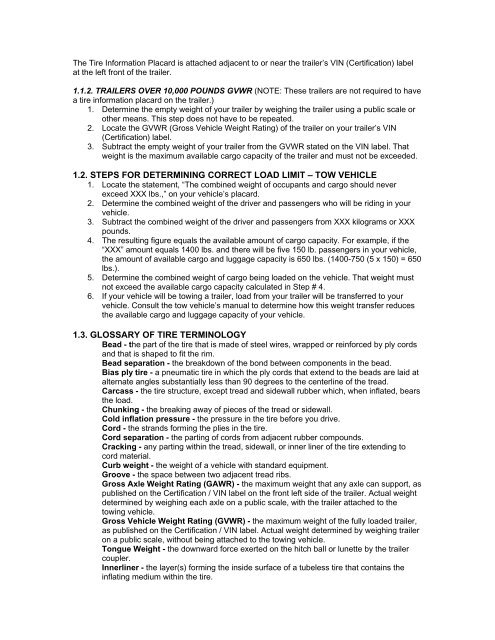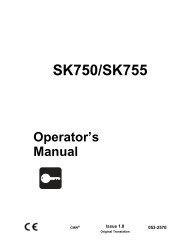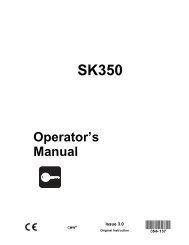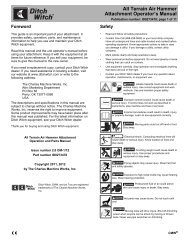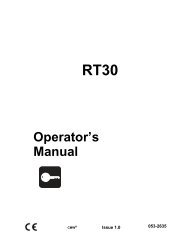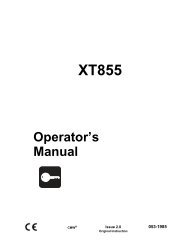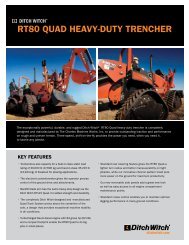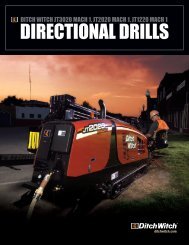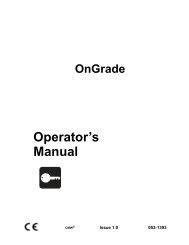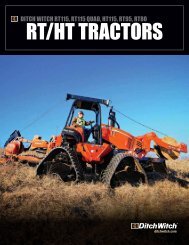FX30 Manual - Ditch Witch
FX30 Manual - Ditch Witch
FX30 Manual - Ditch Witch
Create successful ePaper yourself
Turn your PDF publications into a flip-book with our unique Google optimized e-Paper software.
The Tire Information Placard is attached adjacent to or near the trailer’s VIN (Certification) label<br />
at the left front of the trailer.<br />
1.1.2. TRAILERS OVER 10,000 POUNDS GVWR (NOTE: These trailers are not required to have<br />
a tire information placard on the trailer.)<br />
1. Determine the empty weight of your trailer by weighing the trailer using a public scale or<br />
other means. This step does not have to be repeated.<br />
2. Locate the GVWR (Gross Vehicle Weight Rating) of the trailer on your trailer’s VIN<br />
(Certification) label.<br />
3. Subtract the empty weight of your trailer from the GVWR stated on the VIN label. That<br />
weight is the maximum available cargo capacity of the trailer and must not be exceeded.<br />
1.2. STEPS FOR DETERMINING CORRECT LOAD LIMIT – TOW VEHICLE<br />
1. Locate the statement, “The combined weight of occupants and cargo should never<br />
exceed XXX lbs.,” on your vehicle’s placard.<br />
2. Determine the combined weight of the driver and passengers who will be riding in your<br />
vehicle.<br />
3. Subtract the combined weight of the driver and passengers from XXX kilograms or XXX<br />
pounds.<br />
4. The resulting figure equals the available amount of cargo capacity. For example, if the<br />
“XXX” amount equals 1400 lbs. and there will be five 150 lb. passengers in your vehicle,<br />
the amount of available cargo and luggage capacity is 650 lbs. (1400-750 (5 x 150) = 650<br />
lbs.).<br />
5. Determine the combined weight of cargo being loaded on the vehicle. That weight must<br />
not exceed the available cargo capacity calculated in Step # 4.<br />
6. If your vehicle will be towing a trailer, load from your trailer will be transferred to your<br />
vehicle. Consult the tow vehicle’s manual to determine how this weight transfer reduces<br />
the available cargo and luggage capacity of your vehicle.<br />
1.3. GLOSSARY OF TIRE TERMINOLOGY<br />
Bead - the part of the tire that is made of steel wires, wrapped or reinforced by ply cords<br />
and that is shaped to fit the rim.<br />
Bead separation - the breakdown of the bond between components in the bead.<br />
Bias ply tire - a pneumatic tire in which the ply cords that extend to the beads are laid at<br />
alternate angles substantially less than 90 degrees to the centerline of the tread.<br />
Carcass - the tire structure, except tread and sidewall rubber which, when inflated, bears<br />
the load.<br />
Chunking - the breaking away of pieces of the tread or sidewall.<br />
Cold inflation pressure - the pressure in the tire before you drive.<br />
Cord - the strands forming the plies in the tire.<br />
Cord separation - the parting of cords from adjacent rubber compounds.<br />
Cracking - any parting within the tread, sidewall, or inner liner of the tire extending to<br />
cord material.<br />
Curb weight - the weight of a vehicle with standard equipment.<br />
Groove - the space between two adjacent tread ribs.<br />
Gross Axle Weight Rating (GAWR) - the maximum weight that any axle can support, as<br />
published on the Certification / VIN label on the front left side of the trailer. Actual weight<br />
determined by weighing each axle on a public scale, with the trailer attached to the<br />
towing vehicle.<br />
Gross Vehicle Weight Rating (GVWR) - the maximum weight of the fully loaded trailer,<br />
as published on the Certification / VIN label. Actual weight determined by weighing trailer<br />
on a public scale, without being attached to the towing vehicle.<br />
Tongue Weight - the downward force exerted on the hitch ball or lunette by the trailer<br />
coupler.<br />
Innerliner - the layer(s) forming the inside surface of a tubeless tire that contains the<br />
inflating medium within the tire.


